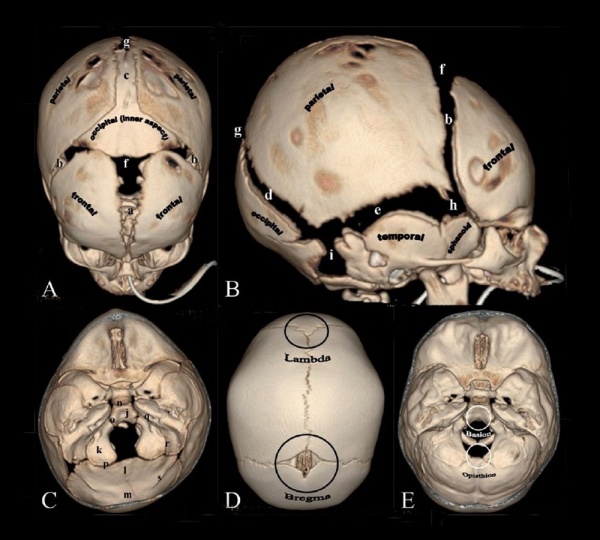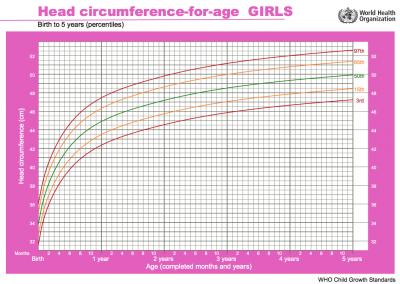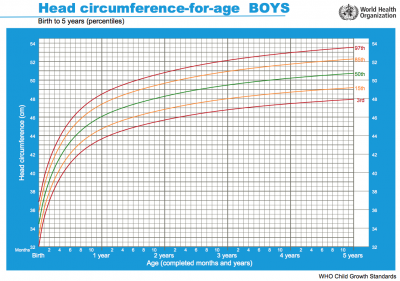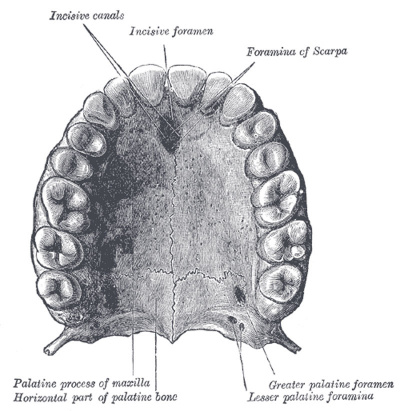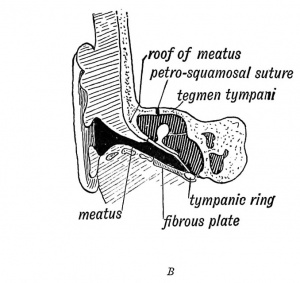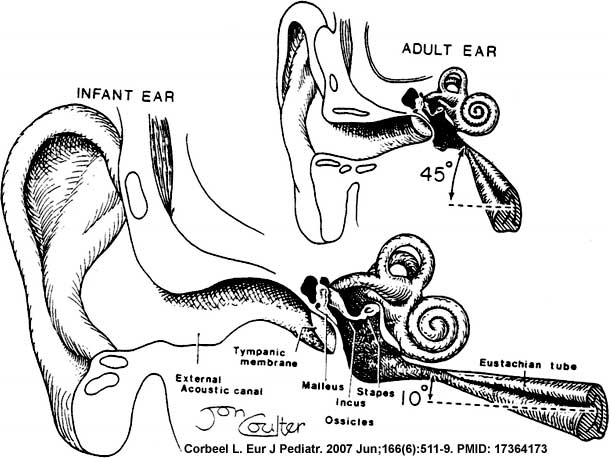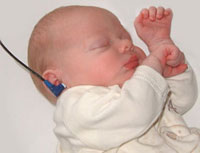Hearing and Balance Development
- altricial animal - Term used to describe an animal born in a helpless state, with incomplete development of sensory systems at birth. For example rats and mice are born with incomplete development of visual and auditory systems. (More? Animal Development)
- ampulla - Term used to describe an anatomical dilation of a tube or canal lumen. Anatomical description of the opening end of the uterine tube lying above the ovary and the enlarged initial segmeny of the semicircular canals of the inner ear vestibular system. (More? inner ear)
- aneurism - (Greek, aneurysma = a widening, aneurysm) A term used to describe an abnormal widening of a vessel or anatomical tubal structure.
- aquaeductus vestibuli - see vestibular aqueduct (More? inner ear)
- auditory neuropathy - (AN) abnormality of transmission of sound information to the brain.
- auditory tube - (eustachian tube) between the middle ear and oral cavity, has a bony (tympanic 1/3) and cartilaginous (pharyngeal 2/3) portion. The main role is equalization of pressure and fluid drainage in the middle ear. (More? middle ear)
- auricular hillock - see hillock (More? middle ear)
- atresia - narrowing, usually of an anatomical tube or cavity.
- autophagocytosis - (Greek, auto = self, phagy = eating, also called autophagy) a cell death mechanism that uses the cell's own lysosomes to self digest.
- border cells - columnar cells within the organ of Corti on the medial portion of the basilar membrane. (More? inner ear)
- canalis reuniens - (ductus reuniens, canaliculus reuniens, canalis reuniens, Hensen's canal, Hensen's duct, uniting canal, canalis reuniens of Hensen) short narrow canal connecting the cochlea duct to the saccule. (Victor Hensen, 1835-1924) (More? inner ear)
- cerumen - (ear wax) produced by glands in the skin of the outer portion of the ear canal. (More? Outer Ear)
- chondrified - the developmental differentiation of cartilage from mesenchye, an embryonic connective tissue.
- cristae ampullaris - located in the ampulla of the membranous semicircular canals a region with both supporting and hair cells. The hair cell cilia are embedded in the gelatinous cupula. (More? inner ear)
- claudius cells - (cells of Claudius) columnar cells with microvilli overlying the basilar membrane and extend from Hensen's cells to the spiral prominence. Barrier cells that lie external to the organ of corti in endolymph. (More? inner ear)
- cochlear sac - embryonic structure, which will form the coiled cochlear duct and contribute to the saccule. (More? inner ear)
- cochlear aqueduct - a bony channel containing the fibrous periotic duct. It connects the basal turn of the cochlea perilymphatic space with the subarachnoid space of the posterior cranial cavity. (More? inner ear)
- cochlin - major constituent of the inner ear extracellular matrix. (More? inner ear)
- collagen type II - major constituent of the inner ear extracellular matrix. (More? inner ear)
- conductive loss - term used to describe one of the two major classes of hearing loss involving external and middle ear abnormalities (other form is Sensorineural loss).
- connexins - channel proteins of the gap junctions that allow rapid communication between adjacent cells. The two connexins Cx26 and Cx30 are the major proteins of cochlear gap junctions.
- connexin 26 - A strikingly high proportion (50%) of congenital bilateral nonsyndromic sensorineural deafness cases have been linked to mutations in the GJB2 coding for the connexin26
- cupular deposits - basophilic material on the cupulae of the semicircular ducts, an postnatal ageing phenomenon seen in some vestibular labyrinth. (More? inner ear)
- clinical weeks - taken from last menstrual period (LMP) and therefore approximately two weeks before fertilization occurs.
- Deiters' cells - (outer phalangeal cells)
- discoidin domain receptor 1 - (DDR1) a tyrosine kinase receptor activated by native collagen, expressed in the basement membrane and with fibrillar collagens. Found in basal cells of the stria vascularis, type III fibrocytes, and cells lining the basilar membrane of the organ of Corti.
- ductus utriculosaccularis - inner ear structure, a canal from the utricle that joins the ductus endolymphaticus from the saccule posterior wall, and then passes along the aquaductus vestibuli and ends in a blind pouch (saccus endolymphaticus) in the petrous portion of the temporal bone, also in contact with the dura mater. (More? image | balance | inner ear)
- endochondral ossification - the process of bone formation from a pre-existing cartilage template. (More? middle ear)
- endoderm - One of the initial 3 germ cell layers (ectoderm, mesoderm and endoderm) formed by the process of gastrulation. The endoderm forms as a cuboidal epithelium and contributes not only to the trilaminar embryo, but also lines the yolk sac. It will form the entire epithelial lining of the gastrointestinal tract (GIT), contribute to the accessory organs of GIT and also forms the epithelial lining of the respiratory tract.
- endolymphatic fluid - (endolymph, Scarpa's fluid) fluid that fills all the membranous labyrinth of the inner ear, except for the cochlea scala tympani and scala vestibuli which are filled with perilymph.
- endolymphatic sac - inner ear structure that has anatomically both an intraosseous and extraosseous component. Th e sac has functions regulating endolymph that are both secretory and absorptive. Also the site of endolymphatic sac tumors either sporadical occurring or associated with the autosomal-dominant von Hippel-Lindau (VHL) disease, due to a germ line mutation. (More? inner ear)
- embryological weeks - taken from the time of fertilization which typically occurs around the middle (day 14), or just after, of the typical 28 day menstrual cycle. (More? Embryonic Development)
- Emx2 - homeobox gene affecting middle ear and inner ear development.
- eustachian tube - (auditory tube) A cavity linking the pharynx to the middle ear, which develops from the first pharyngeal pouch. Named after Bartolomeo Eustachi (1500 - 1574) an Italian anatomist. (More? middle ear)
- external auditory meatus - (ear canal) develops from the first pharyngeal cleft. (More? outer ear)
- espins - calcium-resistant actin-bundling proteins enriched in hair cell stereocilia and sensory cell microvilli and spiral ganglion neurons (SGNs)
- eustachian tube - (auditory tube) between the middle ear and oral cavity, equalization of pressure in the middle ear. (More? middle ear)
- external auditory meatus - (EAM, ear canal) cavity connecting the external ear to the tympanic membrane. The adult human ear canal is about 2.5 cm long and 0.7 cm in diameter. (More? Outer Ear)
- fenestra ovalis - (oval window) separates the tympanic cavity from the vestibule of the osseous labyrinth. (More? inner ear)
- fenestra rotunda - (round window) separates the tympanic cavity from the scala tympani of the cochlea. (More? inner ear)
- fetus - (foetus) term used to describe human development after the 8th week (10th clinical week, LPM) and covers the developmental periods of second and third trimester.
- fibroblast growth factor 1 - (Fgf-1) a growth factor released from cochlea sensory epithelium which stimulates spiral ganglion neurite branching.
- fibroblast growth factor 8 - (Fgf-8) a growth factor released by inner hair cells which regulates pillar cell number, position and rate of development.
- fibroblast growth factor receptor 3 - (Fgfr-3) a tyrosine kinase receptor with a role in the commitment, differentiation and position of pillar cells in the organ of corti
- fundamental frequency - (natural frequency) the lowest frequency in a harmonic series, for the female voice this is about 225 Hz.
- Glaserian fissure - (petrotympanic fissure, squamotympanic fissure) the fissure in the temporal bone that runs between the temporomandibular joint to the tympanic cavity. Named after Johann Glaser (1629–1675) a Swiss anatomist.
- helicotrema - term used to describe the cochlear apex. (More? inner ear)
- Hensen’s stripe - within the cochlea tectorial membrane a ridge that runs longitudinally along the lower surface immediately adjacent to the hair bundles of the inner hair cells.
- Hes - (hairy and enhancer of split) family of factors, which has been shown to be a general negative regulator of neurogenesis (Zheng, 2000).
- hillock - a small hill, used to describe the six surface elevations on pharyngeal arch one and two. (More? outer ear)
- Incus - (anvil) auditory ossicle (More? middle ear)
- inner phalangeal cells - in the cochlea a single row of cells, that along with and three rows of outer phalangeal cells (Deiter's cells), are the hair cell supporting cells. (More? inner ear)
- inner pillar cells - organ of Corti cells arranged in rows and form a boundary between the single row of inner hair cells and three rows of outer hair cells. These cells have surface-associated microtubule bundles. (More? inner ear)
- inner sulcus - area of the cochlear duct. (More? inner ear)
- internal auditory meatus - (internal acoustic meatus, IAM) Anatomical canal in which CN VII and CN VIII ganglia reside and pass through to the brainstem. This bony canal lies between the posterior surface of the petrous pyramid and the bony labyrinth within the dense petrous bone. Also associated clinically with the site where acoustic neuromas may occur. (More? inner ear)
- kimura membrane - (Kimura’s membrane) within the cochlea tectorial membrane a thickening of the lower surface into which the hair bundles of the outer hair cells are imbedded.
- kinocilium - inner ear hair cell specialised type of cilium on the cell apex.
- Kolliker's organ - (Kollicker's organ, greater epithelial ridge) Developing cochlear structure consisting of columnar-shaped supporting cells filling the inner sulcus and lying directly under the tectorial membrane. This transient organ regresses and generates the space of the inner sulcus. Rudolph Albert von Kolliker (1817-1905)?? (More? inner ear
- lateral semicircular duct - (external) (More? image)
- LMP - acronym for last menstrual period, used to clinically measure gestation.
- malleus - (hammer) auditory ossicle (More? middle ear)
- mastoid process - of temporal bone (More? middle ear)
- Math1 - homolog of the Drosophila proneural gene atonal, necessary and sufficient for the production of hair cells in the mouse inner ear. Negatively regulated by Hes1 and Hes5
- meatal plug - temporary blockage of the external auditory meatus which forms at the end of the embryonic period and remains present until the seventh month.
- meatus - anatomical opening, cavity or space (external acoustic meatus, internal auditory meatus)
- mechano-electrical transduction - (MET) occurs within the cochlear hair cells hair bundle. A mechanical stimulus of the hair bundle causes the tip-links to be tensioned, opening ion channels, resulting in the generation of the cell receptor potential. (More? inner ear)
- Meckel's cartilage - first pharyngeal ach cartilage, located within the mandibular prominence. This cartilage first appears at stage 16, stage 20 the beginning of membranous ossification. Named after Johann Friedrich Meckel, (1781 - 1833) a German anatomist. (http://www.whonamedit.com/doctor.cfm/1840.html) (More? middle ear)
- mucopolysaccharidosis - (MPS IIIB, Sanfilippo Syndrome type B) abnormality caused by a deficiency in the lysosomal enzyme N-acetyl-glucosaminidase (Naglu). Children with MPS IIIB develop abnormal hearing, and mental functioning culminating in early death.
- netrin-1 - secreted growth factor, expressed in the organ of Corti and spiral ganglion cells, role in process outgrowth. (More? inner ear)
- otoacoustic emissions testing - (OET) hearing test measures sounds generated by the outer hair cells of the cochlea in response to clicks or tone bursts emitted and recorded by a tiny microphone placed in the infant’s external ear canal. (More? Hearing test)
- olivocochlear - brainstem cholinergic and GABAergic efferent system that innervates sensory cells and sensory neurons of the inner ear.
- organ of Corti - (spiral organ) cochlea component required for converting vibration into neural signals. (More? inner ear)
- organ of Corti protein II - (OCP-II) cytosolic protein or transcription factor? (More? inner ear)
- otolithic membrane - extracellular matrix that cover the sensory epithelia of the inner ear. (More? inner ear)
- ossicle - (small bone, auditory ossicles) the individual bone of the three middle ear bones (malleus, incus, stapes), which reduce vibrational amplitude but increase force to drive fluid-filled inner ear. (More? middle ear)
- otitis media - ICD-11 [1] middle ear infection, peak age prevalence is 6 to 18 months old with many children (75%) have at least one episode by school age. Forms include on-suppurative, suppurative, acute otitis media, chronic otitis media. (More? hearing abnormalities, hearing test)
- otic cup - the early embryonic transient structure formed by the invagination (folding inward) of the otic placode, to cup, then vesicle stage. This will eventually form inner ear structures.
- otic placode - Embryonic ectodermal epithelium giving rise to inner ear structures. (More? inner ear | Placodes)
- otic vesicle - the early embryonic transient structure formed by the invagination (folding inward) and fusion of the otic cup, separating this structure from the embryo surface. This will eventually form inner ear structures.(More? inner ear)
- otoconin - inner ear biominerals required for vestibular apparatus function. (More? inner ear)
- otogelin - (Otog) an inner ear specific glycoprotein expressed in cochlea cells at different developmental times. (More? inner ear)
- otolithic membrane - a membrane within the utricle and saccule containing embedded hair cell cilia and small crystalline bodies of calcium carbonate (otoliths). Functions to detect head motion.
- otoliths - small crystalline bodies of calcium carbonate found within the otolitic membrane of the utricle and saccule. (More? inner ear)
- ototoxic - compound or drug causing temporary or permanent hearing loss. (More? {{hearing abnormalities)
- outer hair cells - (OHCs) three rows of hair cells that function to increase basilar membrane motion through a local mechanical feedback process within the cochlea, the " cochlear amplifier".
- outer pillar cells - arranged in rows and form a boundary between the single row of inner hair cells and three rows of outer hair cells. (More? inner ear)
- paratubal musculature - muscles lying beside the auditory (Eustachian) tube. The tensor veli, palatini (TVP) and tensor tympani muscles. (More? middle ear)
- perilymph - the fluid between the membraneous labyrinth of the ear and the bone which encloses it.
- perilymphatic space - the space between the outer wall of the membranous labyrinth and the wall of the bony labyrinth that contains the perilymph.
- petrous portion of temporal bone -
- pejvakin gene - in humans, two missense mutations in this gene cause non-syndromic recessive deafness (DFNB59) by affecting the function of auditory neurons.
- petrotympanic fissure - (Glaserian fissure, squamotympanic fissure) the fissure in the temporal bone that runs between the temporomandibular joint to the tympanic cavity.
- pharyngeal arch - (More? Outer Ear) pharyngeal pouch pharyngeal membrane Pharynx
- pillar cells - (PC) form an inner and outer row of support cells that form a boundary between inner and outer hair cells. (More? inner ear)
- preyer reflex - ear flick in mouse in response to sound.
- presbyacusis - age-related hearing loss, is the cumulative effect of aging on hearing.
- prestin - a motor protein structurally similar to the anion transporter family expressed in cochlear outer hair cells. (More? inner ear)
- preauricular tag - skin tags located in front of the external ear opening, are common in neonates and in most cases are normal, though in some cases are indicative of other associated abnormalities.
- protocadherin 15 - (Pcdh15) required for initial formation of stereocilia bundles and changes in the actin meshwork within hair cells. The Ames waltzer (av) mouse mutant has both auditory and vestibular abnormalities from a mutation in this gene.
- Reichert's cartilage - pharyngeal arch 2 cartilage, named after Karl Bogislaus Reichert (1811 - 1883) a German anatomist. (More? middle ear | pharyngeal arch)
- Reissner's membrane - (vestibular membrane, vestibular wall) is a membrane located inside the cochlea separating the scala media from scala vestibuli. Named after Ernst Reissner (1824-1878) a German anatomist. It primarily functions as a diffusion barrier, allowing nutrients to travel from the perilymph to the endolymph of the membranous labyrinth.
- rhombomere - hindbrain rostrocaudal segmentation established by expression of Hox homeodomain transcription factors. Histologically rhombomeres are visible as undulating folds (scalloping) of the neural tube in the hindbrain region and have associated cranial nerves.
- saccular macula - (macula of saccule) thickened anterior part of the saccule containing the saccular filaments of the acoustic nerve. (More? balance)
- Saccule - (Latin, sacculus = a small pouch) sensory cells in the inner ear that translate head movements into neural signals for the brain to interpret. (More? balance)
- sacculocollic reflex - thought to have a role in maintaining the relative position of the head and the body against the vertical linear acceleration of gravity.
- scala tympani - one of the three cochlea cavities, it is filled with perilymph.
- Scarpa's ganglion - (vestibular ganglion) primary afferent vestibular neuron ganglion of the vestibular nerve. Located within the internal auditory meatus. (More? inner ear)
- semicircular canals - series of fluid-filled loops of the inner ear required for balance and sensing acceleration. (More? inner ear)
- sensorineural - term used to describe one of the two major classes of hearing loss involving the central pathway from the cochlear (other form is conductive loss).
- space of Nuel - within the cochlea, an organ of Corti space between the outer pillar cells and the phalangeal and hair cells. Named after Jean-Pierre Nuel (1847-1920) a Belgian ophthalmologist. (More? inner ear)
- spiral ganglion neurons - (SGN) innervate the inner (Type I) and outer (Type II) hair cells of the cochlea. (More? inner ear)
- stapedius muscle - (innervated by CN VII tympanic branch) one of the two muscles in the middle ear, contraction of this muscle pulls the stapes and dampens auditory ossicle movement. (More? middle ear)
- startle response - {Moro reflex)
- stereocilia -finger-like projections from the apical surface of sensory hair cells forming the hair bundle in the cochlea. Formed by tightly cross-linked parallel actin filaments in a paracrystalline array with cell surface specializations (tip links, horizontal top connectors, and tectorial membrane attachment crowns).
- stratified squamous epithelia - classification of epithelium which transiently forms a plug in external ear canal to the outer eardrum.
- stria vascularis - forms the outer wall of the cochlear duct of the mammalian cochlea is composed primarily of three types of cells. Marginal cells line the lumen of the cochlear duct and are of epithelial origin. Basal cells also form a continuous layer and they may be mesodermal or derived from the neural crest. Intermediate cells are melanocyte-like cells, presumably derived from the neural crest, and are scattered between the marginal and basal cell layers. The stria forms endolymph and also contains a rich supply of blood vessels. (More? inner ear)
- synostotically - anatomically normally separate skeletal bones fused together. (More? middle ear)
- tectorial membrane - within the cochlea an extracellular matrix produced by interdental cells, that covers the sensory epithelial hair cells of the organ of corti. (More? inner ear)
- alpha-tectorin and beta- (TECTA, TECTB) major non-collagenous protein component of the tectorial membrane forming a striated-sheet matrix. Synthesized as glycosylphosphatidylinositol-linked, membrane bound precursors.
- tensor tympani - (innervated by CN V mandibular nerve) one of the two muscles in the middle ear, contraction of this muscle pulls the malleus and tenses the tympanic membrane, dampening auditory ossicle movement. The muscle arises from auditory tube (cartilaginous portion) and is inserted into the malleus (manubrium near the root).
- tonotopy - term describing the mapping along the tectorial membrane within the cochlea of the different sound frequencies. (More? inner ear)
- tympanic membrane - (ear drum)
- tympanic ring - an incomplete circle, in the concavity of which is a groove, the tympanic sulcus, for the attachment of the circumference of the tympanic membrane. In the newborn the ring is still open and expands laterally to form the tympanic part of temporal bone.
- vestibular evoked myogenic potential - (VEMP) a test for vestibular disorders (utricle and superior nerve) response elicited by loud clicks or tone bursts recorded from the tonically contracted sternocleidomastoid muscle.
- vestibular ganglion - (Scarpa's ganglion) primary afferent vestibular neuron ganglion of the vestibular nerve. Located within the internal auditory meatus. (More? inner ear)
- vestibular membrane - (Reissner's) extends from the spiral lamina to the outer wall and divides the cochlea into an upper scala vestibuli, a lower scala tympani. (More? inner ear)
- Vestibulocochlear Nerve - Cranial Nerve VIII CN VIII
- Whirlin - A PDZ scaffold protein expressed in hair cells at the stereocilia tips, essential for the stereocilia elongation process. The DFNB31 gene mutations cause hearing loss in human and mouse. This protein can interact with membrane-associated guanylate kinase (MAGUK) protein, erythrocyte protein p55 (p55). (More? inner ear)
- Wnt7a - signaling through the Wnt pathway regulates the development of hair cell unidirectional stereociliary bundle orientation. (More? inner ear)
|
